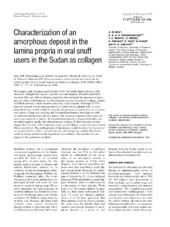Characterization of an amorphous deposit in the lamina propria in oral snuff users in the Sudan as collagen
Idris, Ali M.; Warnakulasuriya, K. A. A. Saman; Ibrahim, Y. E.; Hartley, R.; Paterson, K.; Patel, B.; Nilsen, Rune; Johnson, N. W.
Peer reviewed, Journal article
Permanent lenke
https://hdl.handle.net/1956/2156Utgivelsesdato
1998-04Metadata
Vis full innførselSamlinger
Originalversjon
https://doi.org/10.1111/j.1600-0714.1998.tb01933.xSammendrag
Histological and ultrastructural features of 25 oral snuff dipper's lesions with distinctive subepithelial hyaline deposits were investigated. Periodic acid-Schiff reaction with and without diastase digestion demonstrated the presence of glycogen and other carbohydrates, but histochemical stains for normal collagen, elastin and fibrin showed a weak variable reactivity of the deposit. Although in 7/25 cases the deposit was in close proximity to labial salivary glands and on occasions ducts were found within the deposit, the presence of mucin was not a consistent feature. Congo red staining and immunohistochemical investigation with an anti-amyloid antibody did not support the previous contention that such deposits were amyloid in nature. Immunohistochemically, collagen antibodies also provided negative results, but ultrastructural features of three biopsies studied suggest that the bulk of this deposit is made up of collagen, as typical cross-striated fibrils were found. The pathogenesis of this deposit could therefore be interpreted as over-production and/or reduced turnover of collagen by resident fibroblasts, which is further altered by the ingredients of toombak. The deposit does not appear to be a secretory product.
